Installation artist Haegue Yang, internationally active from her bases in Berlin and Seoul, interprets everyday household objects in varied ways. Her latest exhibition at the National Museum of Modern and ntemporary Art (MMCA) in Seoul highlights the ongoing expansion of her genre-defying boldness as she muses on new questions.
Haegue Yang explores the potential of mundane objects such as laundry racks, Venetian blinds and light bulbs as her motifs – and has been remarkably successful in doing so. In one of her seminal works, “Salim” (Korean for “homemaking”), presented at the Korean Pavilion for the 2009 Venice Biennale, she created a kitchen out of steel frames, fans and yarn.
Yang’s multimedia installations typically consist of standard household objects that have been transformed for a variety of new possibilities, often set against digital wallpapers with graphic design. Disconnected images are interwoven in a complex way; critics say they find the high image density difficult to take in all at once. She responds that abstruseness characterizes her works.
Her latest exhibition at the National Museum of Modern and Contemporary Art in Seoul, “MMCA Hyundai Motor Series 2020: Haegue Yang – O2 & H2O” (September 29, 2020-February 28, 2021), is no exception. What first greets visitors is a huge piece, “Silo of Silence – Clicked Core.” With its inscrutable title, the 11-meter-high installation takes the form of a large mobile composed of Venetian blinds and lighting fixtures. Dark blue and black blinds revolve in their respective orbits. Visitors can freely appreciate the exhibit from afar and from underneath; the impressive size and colors moving in slow motion create enigmatic spatial experiences.
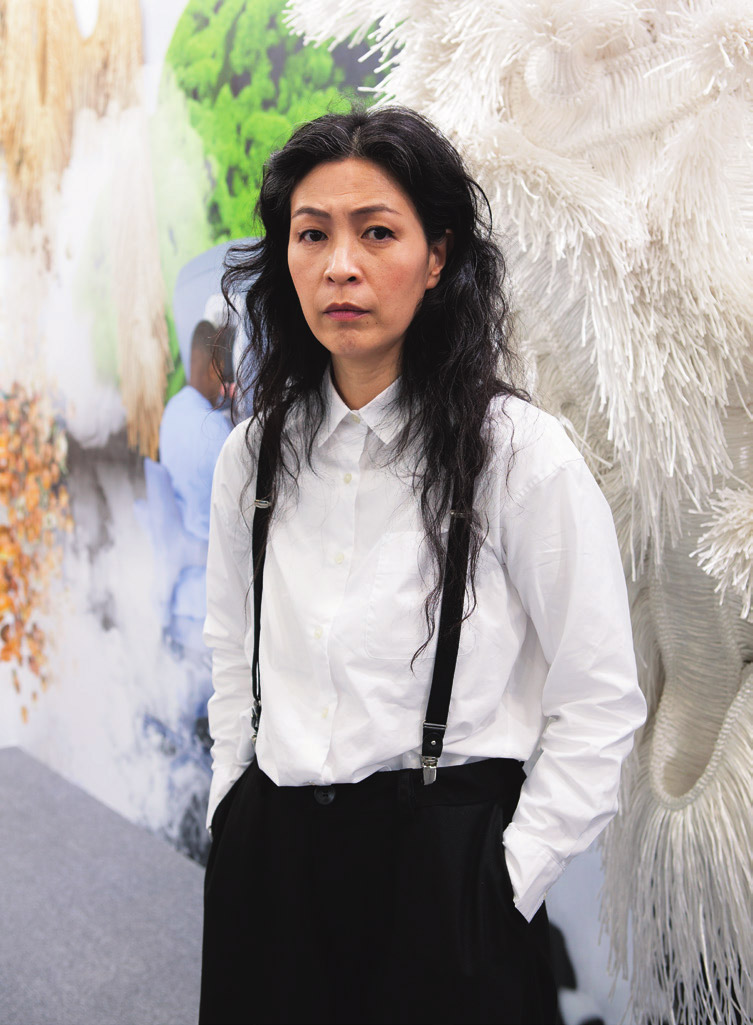
Haegue Yang poses at the inaugural Taipei Dangdai art fair, held at Taipei Nangang Exhibition Center in January 2019. © Sebastiano Pellion Di Persano / Courtesy of MMCA
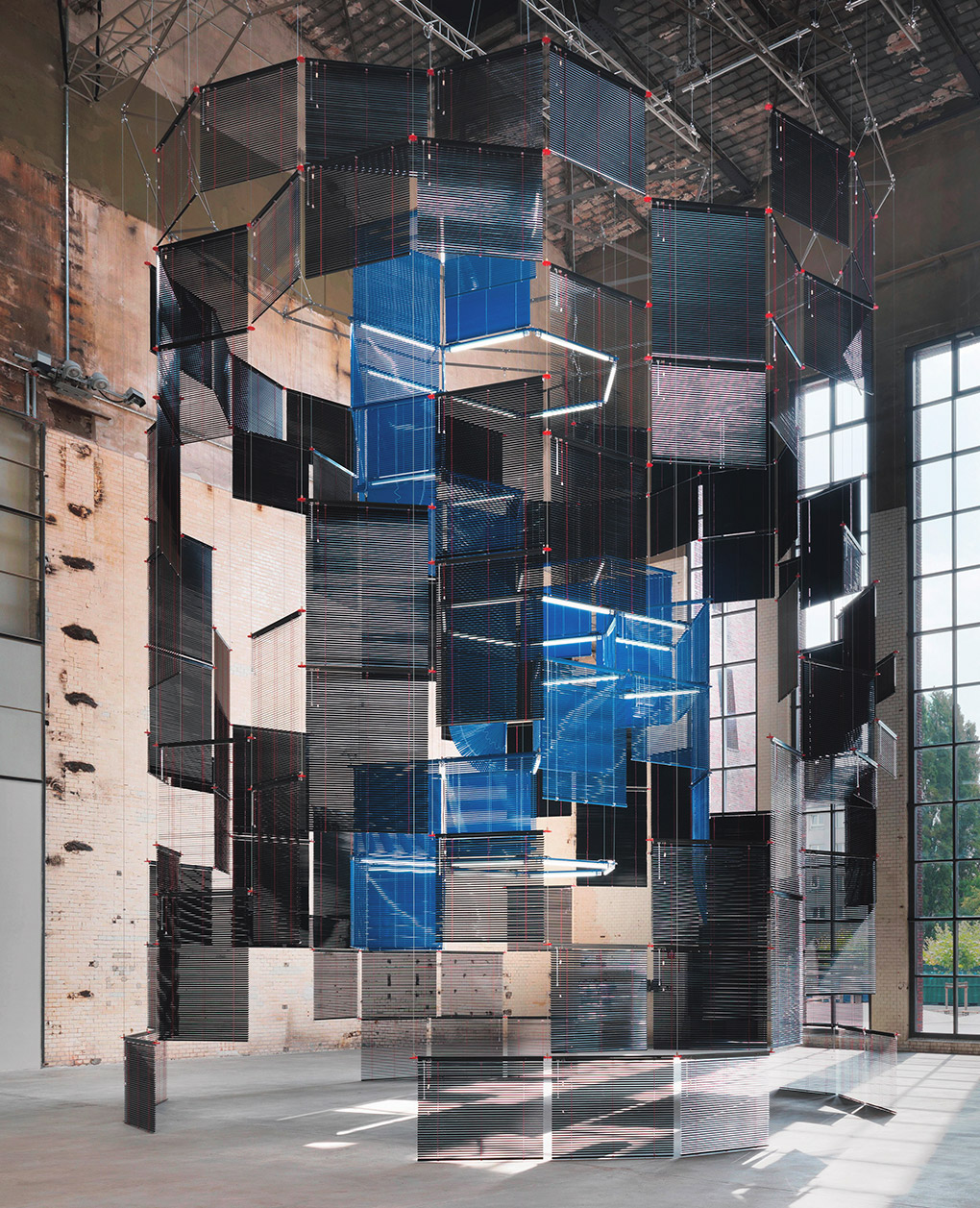
“Silo of Silence – Clicked Core.” 2017. Aluminum Venetian blinds, powder-coated aluminum and steel hanging structure, steel wire rope, revolving stage, LED tubes, cable. 1105 × 780 × 780 cm. KINDL – Centre for Contemporary Art in Berlin invites one artist every year to present a single artwork in the 20-meter-high Boiler House, a typical post-industrial site. This cylindrical, moving installation by Hague Yang was exhibited from September 2017 to May 2018. © Jens Ziehe / Courtesy of Haegue Yang
One Object, Varied Interpretations
The Venetian blinds used here are the same as those featured in Yang’s best-known work, the “Sol LeWitt Upside Down” series, which can be seen further inside the exhibition hall. Created out of white blinds, it has strong minimalist features, as can be inferred from the name of the American artist in the title.
Regarding the Venetian blinds, Yang said that some people may perceive them as an Asian material and others as a Western material. Depending on individual perspectives, then, some may be reminded of Asian bamboo blinds whereas others might associate them with a Western office space. Evident in Yang’s other works is the artist’s same intention to show how an object can take on altered meanings in different contexts.
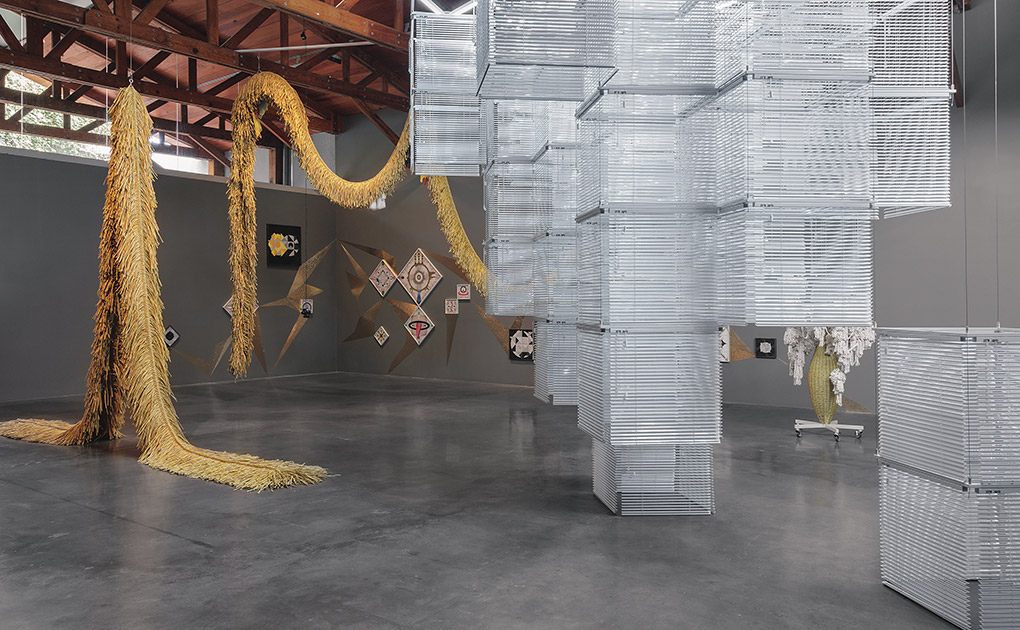
A view of “Ornament and Abstraction,” Yang’s first solo exhibition in Latin America, held in Mexico City’s kurimanzutto art gallery in 2017. The works on exhibit are:
“The Intermediate – UHHHHH Creature Extended W.” 2017. Artificial straw, powder-coated stainless steel hanging structure, powder-coated stainless steel frame, steel wire rope, Neoseul, Bupo. 580 × 750 × 60 cm.
“Big-eyed Tongue-tied Mountains beneath Solar and Lunar Orbs – Trustworthy #315.” 2017. Various security envelopes, graph paper, origami paper, and sandpaper on cardboard, framed, self-adhesive vinyl film. 11 parts. 86.2 × 86.2 cm; 57.2 × 57.2 cm; 29.2 × 29.2 cm.
“Sol LeWitt Upside Down – K123456, Expanded 1078 Times, Doubled and Mirrored.” 2017. Aluminum Venetian blinds, powder-coated aluminum hanging structure, steel wire rope, fluorescent tubes, cable. 878 × 563 × 1088 cm. © Omar Luis Olguín / Courtesy of kurimanzutto
Mixed Boundaries
Most prominently on display in Gallery 5 is a group of sculptures entitled “Sonic Domesticus,” which are built of artificial straw, plastic ropes and brass bells. The brass bells lining the surface of these sculptures create an initial impression of exotic living organisms. Gradually, one can make out the shapes of irons, computer mice, hairdryers and pots.
While she attempts to define differences between East and West in her works built of Venetian blinds, here Yang appears to probe the boundary between animate and inanimate objects. Hairdryers take on the form of a crab; two computer mice stacked on top of one another resemble the body of an insect; and irons are adjoined to evoke a pair of scissors. The pieces stand on wheels and produce sounds when moved.
The wall to the right of these sculptures features four types of handles attached in nonagonal formation, apparently designed for a similar effect. The artist clearly wanted to demonstrate how contexts change the meaning of objects: doorknobs attached to the wall lose their original function of opening a door.
Some may say that this is a familiar strategy dating back a century to the Dada artists. Long before Yang crossed two irons to create a shape reminiscent of scissors, visual artist Man Ray created “Cadeau” in 1921. He attached a row of nails to the bottom of an iron to nullify the object’s function and meaning. Going back even further, Yang’s work recalls Marcel Duchamp’s 1917 piece, “Fountain,” a urinal brought into a museum.
There is no doubt that a marked trend in today’s international art scene is to freely draw inspiration from ideas dating back to any era in art history. This may lead one to naturally search for Yang’s own unique voice in borrowing ideas from conceptual art.
From exploring the boundaries between East and West, and animate and inanimate objects, the artist seems to be moving toward questioning the divide between real and virtual, and between genuine and fake.
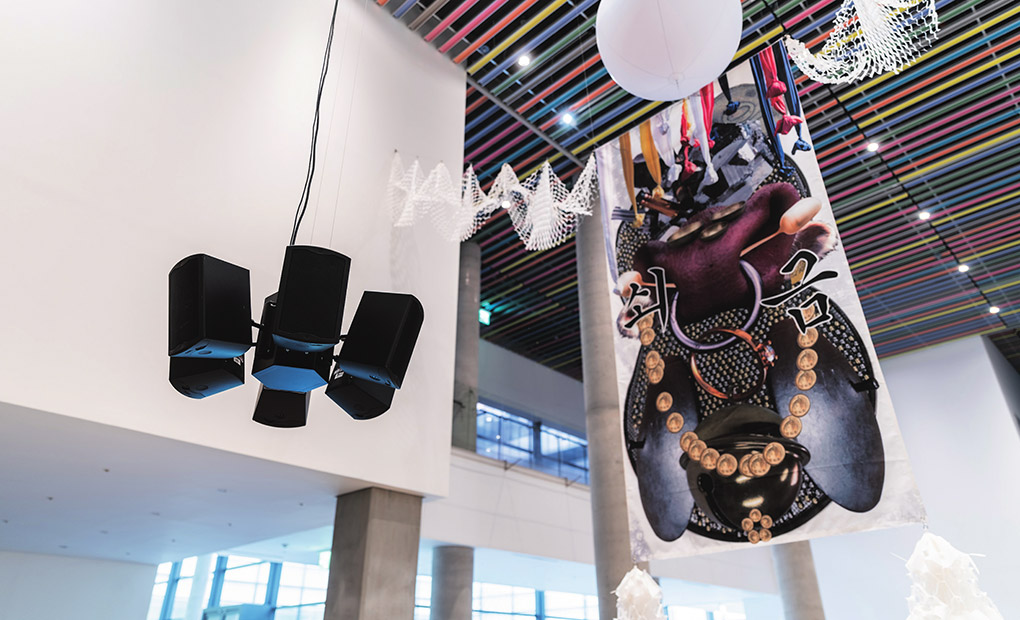
At “MMCA Hyundai Motor Series 2020: Haegue Yang – O2 & H2O,” held from September 29, 2020 to February 28, 2021, Yang displayed new forms of art, including her voice replicated via artificial intelligence and a digital collage on banners.
(Left) “Genuine Cloning.” 2020. AI (Typecast), Haegue Yang’s voice, speakers. Dimensions variable. Technology by Neosapience.
(Right) “Five Doing Un-Doing.” 2020. Water-based inkjet print on polyester banners, ad balloons, eyelets, steel wire rope, hanji. Dimensions variable. Graphics by Yena Yoo.
© Cheolki Hong / Courtesy of MMCA
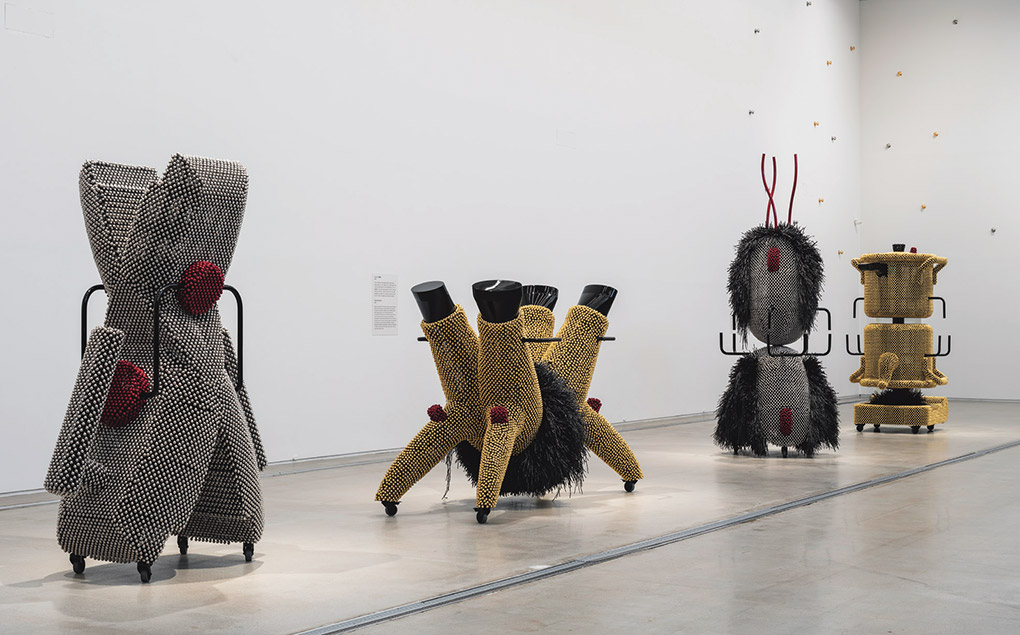
In this series of works, Yang created hybrid vessels by adjoining or crosslinking mundane items such as irons, hairdryers, computer mice and pots.
“Sonic Domesticus.” 2020. Powder-coated stainless steel frame, powdercoated mesh, powder-coated handles, casters, black brass and brass plated bells, red stainless steel and stainless steel bell, metal rings, plastic twine.
From left:
“Sonic Domesticus – Scissor Pressing.” 208 × 151 × 86 cm.
“Sonic Domesticus – Blow-Dry Crawl.” 155 × 227 × 115 cm.
“Sonic Domesticus – Clam Tongs.” 291 × 111 × 97 cm.
“Sonic Domesticus – Pot Atop.” 224 × 176 × 122 cm.
Reality and Abstraction
That voice is perhaps clearest in a new form of art that Yang introduces in “Five Doing Un-Doing,” a collage of digital images on banners; and “Genuine Cloning,” a collection of speakers that transmit an AI-generated voice.
In her own words, “Five Doing Un-Doing” is “characteristic of loud graphics and overblown typography resembling political propaganda.” On the five banners are written the names of the five elements (wood, fire, earth, metal and water) symbolized by the colors representing the five cardinal directions (blue, red, yellow, white and black). The bottom of the banners is adorned with tassel-like shamanic paraphernalia created using traditional Korean paper, hanji. This installation in particular appears highly relevant to the title of the exhibition, “O2 and H2O.” Yang says she keyed in on how oxygen and water, both ubiquitous elements of everyday life, are coded as O2 and H2O. Thus, she explains that she has abstracted reality into five elements in her own way.
“Genuine Cloning” is an installation of speakers hung between the five banners. The speakers play Yang’s voice, cloned using AI technology. From exploring the boundaries between East and West, and animate and inanimate objects, the artist seems to be moving toward questioning the divide between real and virtual, and between genuine and fake.
Between Berlin and Seoul
Born in Seoul in 1971, Yang moved to Frankfurt, Germany in 1994 and graduated from Städelschule, the State Academy of Fine Arts. Since 2005, she has lived and worked in Berlin; in 2014, she set up an additional studio in Seoul and now travels back and forth between the two cities. In 2018, she made headlines by becoming the first Asian woman to receive the Wolfgang Hahn Prize, which honors contemporary artists.
Last year, despite the coronavirus pandemic, Yang’s works were exhibited in many venues around the world. She presented six dynamic sculptures in an exhibition titled “Handles” (October 21, 2019-February 28, 2021), commemorating the reopening of the Museum of Modern Art (MoMA) in New York; and “Strange Attractors” (October 24, 2020-September 26, 2021) at Tate St Ives in Cornwall, England.
The MMCA Hyundai Motor Series is the museum’s annual event held in support of major artists. This marks Yang’s first solo exhibition at the MMCA.